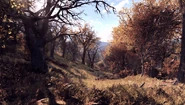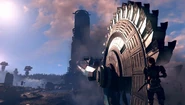Appalachia, also known as the Appalachian Territories, Appalachia Territory and the Territory of Appalachia, is the name given to a region encompassing post-apocalyptic West Virginia.
Located within the Eastern Commonwealth of the former United States, the region was spared most of the destruction and carnage of the Great War due to its relative isolation and lack of strategic targets, but much of the surviving human population nonetheless perished over the following years due to the Scorched Plague. In 2102, the residents of Vault 76 emerged into Appalachia after twenty-five years of isolation and began to reclaim the wilderness.
It serves as the game-world of Fallout 76.
Background
Early history
One of the more unique regions in the United States, Appalachia has been a land of contrasts for much of its existence. First settled by Native American hunter-gatherers over 16 000 years ago, it was opened up to European settlement by French and English explorers in the 16th century. Migration began in the 18th century, with immigrants pushing into the Appalachians. The immigrants came from a number of countries, including Ulster Scots, Germans, English, and others. The demanding climate of the Appalachians combined with the wealth of natural resources resulted in the birth of a distinct cultural identity: A romanticized community of frontiersmen distinct from the wealthier neighbors in the neighboring regions. The result was friction and regular conflicts, especially over taxation. However, the differences were yet to come to a head.[1]
They did come during the American Civil War, when Appalachia's riches and strategic transit routes turned it into a vital prize for both the federal forces and the rebels. The northwestern part of Virginia, a majority Union territory, seceded from the Confederacy and was reformed into a separate state of West Virginia, only adding fuel to the fire. Over the next four years, the region suffered as conventional warfare, sabotage, bushwhacking, and scorched earth tactics ruined the economy, the cities, and took countless lives. The destruction wrought by both the Union and the Confederacy led to the lasting distrust of outsiders and the government. However, Appalachia recovered after the war, in no small parts thanks to the rapid industrialization of the United States and the rich deposits of ore, coal, and timber in the region. Pittsburgh and other cities grew to prominence as centers of industry, while the mining industry blossomed.[1]
However, the fruits of the growth were not split equally. The rapid development of laissez-faire capitalism, complete with non-existent labor laws and underfunded police forces led to sharp divide between the haves (the owners of the mines) and the have-nots (the laborers), culminating in a series of conflicts collectively termed the Coal Wars. West Virginia was one of the most important stages of these conflicts, due to the widespread exploitation of workers through company towns, private police forces, and union crackdowns. By 1921, the conflict would include regular warfare between miner militias and private contractors backed by the coal owners. The culmination of the West Virginia coal wars was the Battle of Mount Blair, where miners faced off against private detectives, policemen, sheriff's deputies, and even the United States Army. The arrival of the Army forced the miners to concede defeat. However, the victory proved to be a Pyrrhic one: The owners of the coal industry benefited in the short term, but the wars paved way for future organized labor initiatives, at least into the 21st century.[1]
21st century
By the late 21st century, Appalachia's political and economic landscape shifted away from its frontier roots and mining, but remained plagued by many of the same problems. Although mining remained a major part of its economy, West Virginia experienced a boom in other sectors, including ever-lucrative tourism, cutting-edge robots, defense, and many more. However, the pressures of the resource crisis and the rise of organized oligarchic interests - powerful megacorporations like Poseidon Energy, West Tek, Atomic Mining Services, RobCo Industries and others - reverted the gains of the organized labor movement of the 20th century. The economic boom that continued in spite of the Resource Wars crippling economies was leveraged primarily by the rich.
The United States government and the military proved indifferent to the plight of the common man, using the situation as an opportunity to expand the network of military facilities across Appalachia, especially the central part of the Appalachian mountains. The most notable developments included the Whitespring Congressional Bunker constructed using funds embezzled from the Department of Agriculture, the Sugar Grove Naval Intelligence Station, National Isolated Radio Array, and of course, the three fully automated missile silos equipped with an advanced robotic construction system, allowing them to rapidly refill their arsenals in a matter of hours, allowing the United States to retain nuclear strike capability even in the face of total societal collapse. Many other prototype technologies were developed and tested in the region. Late in 2060, the U.S. military deployed their unmanned Cargobots all over Appalachia. They proved ideal for providing reconnaissance and delivering supplies in even the most hostile conditions.[2]
The situation only got worse as the Sino-American War dragged on, siphoning people, money, and materiel for the war effort. The state of total war turned the United States into a mockery of democracy: Victory was everything and the military-industrial complex was given free reign as to the methods of achieving that goal. In Appalachia, this took the form of ruthless exploitation of resources and people. Vault-Tec effectively privatized Morgantown after taking over its community college and rebranding it Vault-Tec University. Grafton Steel turned the northern end of The Forest into the Toxic Valley. Hornwright Industrial Mining Company turned Mount Blair and its environs into the Ash Heap using The Rockhound from 2070 onwards, then set the abandoned mines on fire to extract trace amounts of minerals from the smoke using ash forges. The Watoga National Park was scrapped and the forests ripped up from the ground to make way for The City of the Future, while AMS tore through the Cranberry Bog with underground nuclear tests to create ultracite.
Against this backdrop of mindless greed and devastation, the common man suffered. As early as 2061, the region was rife with homeless, itinerant workers in the region struggling to make ends meet or provide for their families.[3] Many of them lost their jobs to rapid automation implemented by the corporations to improve their bottom line. Many of the affected workers were miners. RobCo was key in this scheme: Its wide range of robots was ostensibly meant to replace human workers in jobs deemed too dangerous, but many people in Appalachia rightly saw them as a threat to their jobs. First, they replaced miners. Then construction workers. Then police men and soldiers. Eventually, they even came for service workers. What was supposed to be a boon for everyone turned out to be a benefit for the few.[4][5]
The Free States were one of the few well-organized groups in Appalachia that fought against this trend. Deeply suspicious of the motives of the government, military, and big money, they were vilified as seditionists, conspiracy nutjobs, and crypto-communists. Persecution by the United States military and accusations of sedition culminated in the Free States openly seceding from the nation and retreating to fortified bunkers erected across the bogs of the northeast.[6]
Elsewhere, the situation was getting even worse. The frenzied campaign of automation culminated with Ballot Measure 6. Set for a vote in November, the measure would issue a $2.6 billion bond to begin the process of replacing all human workers in the Appalachian government with automated systems, with the goal of complete automation by 2087. Among many in the region, it became an overt example of the proxy war between local workers and the conglomerates such as the aforementioned Hornwright Industrial and Atomic Mining Services, driving the shift away from traditional labor. Among the many opponents of the measure, Senator Sam Blackwell was the most notable, advocating against what he described as a "slow-moving disaster" that would leave the people with nothing but pink slips and empty bellies.[7]
Last days
The unrest peaked when AMS forced families out of the town of Welch in early October 2077. The disenfranchised workers of Appalachia rose up against the corporations, leading to riots across the region. The fighting was particularly severe around Charleston and The Ash Heap. On Mount Blair, miners seized the Rockhound, a despised symbol of automation. For eight days, the miners held out, striking and demanding a right to work, until the National Guard sent in specially-designed fleets of combat robots - Strikebreakers, commissioned by Hornwright in the wake of the mine protests - to eliminate the rioters. Echoing the events of the battle of Mount Blair over 150 years earlier, the Strikebreakers took out the miners and returned control of the Rockhound to Hornwright.[8]
The last battle of this campaign for the soul of Appalachia took place at Lewisburg on October 18, 2077. In a highly publicized showdown, the Hornwright Industrial Mining Company deployed its autonomous auto-miner unit and Garrahan Mining Company fielded their tenacious Excavator power armor to settle once and for all whether it was man or machine who reigned supreme. Both effortlessly chewed through the rock at their designated sites, and at the end of the day, Hornwright had the edge winning by a mere margin of 1.85 tons. Although victorious and poised to implement its plans for Appalachia on a great scale, the victory was short-lived, thanks to the Great War.[9]
Post-War
Although Appalachia was largely spared from nuclear devastation, with few direct nuclear strikes, it was not spared either fallout or societal collapse. Although government officials made it to the Whitespring Congressional Bunker, no continuity could be established due to the Enclave's purges that eliminated all unaffiliated personnel. Appalachia was left to fend for itself as Thomas Eckhart, the leader of the Enclave, focused his attention on continuing the war against China.[10]
The survivors did not sit idle, however. In Charleston, abandoned by governor Evans and his cronies, the Appalachian Territory officials organized an emergency government together with the first responders. Charleston became an oasis of stability amidst the devastation and chaos. Elsewhere, survivors rarely had as much luck. Taggerdy's Thunder and other military units were lost without contact with command and decided to sit tight, waiting for orders. The fate of civilians outside Charleston depended largely on where they wound up. Watogans fared the worst, forced out of their city by a virus attack that hit it shortly before the bombs dropped. Morgantown was torn apart by rival cliques formed by the students of Vault-Tec University. Harpers Ferry struggled to survive against a rapidly mutating, changing mire outside its walls.
The worst fate awaited the affluent vacationers in the elegant resorts that dotted the Appalachians. Snowed in and isolated from the rest of Appalachia, they soon learned how relative wealth could be. Their money, power, and influence turned out to be meaningless when the food supplies ran out part-way through the winter and they turned on one another, fighting over scraps just to survive. The experience of the winter of 2078 broke many of them, leading to the violent birth of raiders.
The following years proved to be difficult, but hopeful. The Responders steadily expanded their sphere of influence from Charleston, while Camp Venture served as the nucleus of a new chapter of the Brotherhood of Steel under Paladin Lizzy Taggerdy. The Free States also left their bunkers in 2079, retaking Harpers Ferry and the Thunder Mountain power plant (before the Brotherhood wrestled control of it from them).[11]
However, the peace was not to last. As the region entered the 2080s, dark clouds gathered on the horizon. President Thomas Eckhart, in a bid to raise the DEFCON level for Appalachia, monitored by automated security, started unleashing horrors on the region, beginning with the Chinese Liberators secured at Fujiniya Intelligence Base, a covert intelligence facility established to monitor the region's "factory cities" and later missile silos. Worse yet, the raiders grew in strength and clashed with the Responders. On Christmas Day 2082, after losing a patrol to Charleston and with it, his lover, Rosalynn Jeffries, David Thorpe, the leader of the Pleasant Valley raiders, blew up the Summersville Dam with mini nukes stolen from the Brotherhood, wiping Charleston out.[12]
Although the raiders won the battle, they attracted the attention of the elusive Order of Mysteries, which started a campaign of covert operations against them, buying time for the Responders to rebuild at Morgantown. Ironically, the move solidified relations between the Responders and the Brotherhood, as well as opened relations with the Free States. The Responders and the Brotherhood together fought at Huntersville against super mutants unleashed from behind the scenes by Eckhart and the Enclave in January 2086. The victory at Huntersville promised a new dawn for Appalachia.[13]
It would not be. Desperate to trick the DEFCON system, Eckhart released the scorchbeasts in the Cranberry Bog, a project he kept secret even from his officers. As the Enclave descended into an ultimately lethal civil war between his loyalists and those too disgusted to follow the President's orders, the monsters wrought havoc on the region, steadily spreading out. Harpers Ferry was destroyed in 2086, ending a seven year long project and forcing the Free States back to square one, while the Brotherhood focused on the threat, relying on the Responders for a good part of their logistics. The Responders took umbrage to this and relations slowly soured. The raiders, once suppressed by a combination of the Order of Mysteries' operations and join Responder/Brotherhood patrols, reemerged in the Divide, taking territory once more and destroying the Order thanks to a defector from their ranks.
Extinction Event
The next decade was marked by a steadily disintegrating social order across Appalachia, as each faction focused on itself and its goals, instead of working together. The Free States struggled to come up with a response and their plans for an Appalachia-wide Scorched Detection System were hamstrung by the isolation and the mountains filled with raiders. The Brotherhood fought a desperate campaign to contain the threat in the Bog, with dwindling support from the Responders. The Responders, in turn, struggled to cope with the increasing number of clashes with the raiders and the influx of scorched coming over the mountains.
The situation was untenable. By 2095, the Brotherhood was on its last legs. After pulling out from all outlying positions and rallying at Fort Defiance and Thunder Mountain power plant, they launched Operation Touchdown in January 2095, losing its most veteran members, including Paladin Taggerdy. Although she succeeded in temporarily holding the scorchbeasts back, the communications breakdown prevented them from building on this success and the Brotherhood fell in August 2095.[14]
With nobody to hold the line, the scorchbeasts and their minions spread across the adjacent regions, claiming the Free States and the raider gangs of the Divide first. The disintegrating warbands, in a panicked flight eastwards, clashed with the Responders, destroying Flatwoods and other outlying outposts. Realizing the magnitude of the threat, the Responders attempted to counterattack by coming up with a vaccine for the Scorched Plague and launching surgical strikes against locations like Big Bend Tunnel, to stem the tide. However, it was too little, too late. By November 2096, the scorchbeasts and their minions had the upper hand, descending on Morgantown Airport and destroying the last major stronghold of humanity in Appalachia.
Poised to become an extinction-level event for humanity if left unchecked, the scorchbeasts continued to multiply and spread, using fissures below the earth as nests. In the background, the automated Appalachia trudged on, with robots going through the motions, serving nobody. It wasn't until 2102 and the opening of Vault 76 that humanity returned to Appalachia and the Vault dwellers, confronted with the hostile world, took upon themselves the burden of saving humanity.[15]
Regions
The Forest
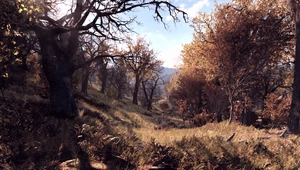
Lush greenery defines the Forest, an almost pristine region of Appalachia.
Bounded by the Ohio River to the west and the Allegheny Mountains to the east, the Forest is a loosely-defined geographic area notable for its diverse fauna and flora. Home to a wide range of industries before the Great War, including logging, agriculture, tourism, and even high technology sectors spurred by Vault-Tec in Morgantown and Hornwright Industrial Mining Company in Charleston, the region became a haven for survivors, thanks to its rich plant and animal life, and ample supply of food and water.[16]
The Forest was controlled predominantly by the Responders, who leveraged the intact infrastructure and resources in their attempt to rebuild Appalachia. A quarter of a century later, the region is still rich in both and effectively a springboard for rebuilding human civilization. However, although relatively untouched by the bombs, the Forest region of Appalachia is still home to the mutated beasts that now roam the countryside.[16]
Ash Heap
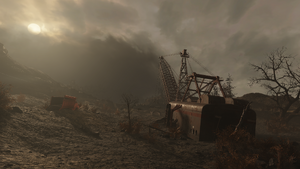
The polluted, inhospitable territory of the Ash Heap, with an almost perpetually overcast sky created by the dense smog blanketing Mount Blair and its surroundings.
Sitting on the southern edge of the Forest, beyond Charleston, the Ash Heap is a descriptive term used to refer to the polluted areas surrounding Mount Blair. Historically a center of Appalachian mining thanks to rich deposits of coal and numerous metals, the Ash Heap gained its name after liberal exploitation of the resources and especially strip-mining the mountaintop resulted in incredible amounts of pollution, turning the ground, water, and even the very air into poison.[17]
The destruction of the region accelerated in 2070, with the activation of The Rockhound by Hornwright Industrial Mining Company on top of Mount Blair. As the ecosystem collapsed, the mining operations expanded, helmed by Hornwright and its competitors, Garrahan Mining Company. Perhaps the greatest damage was done by Hornwright when the company took purifiers offered by the Clear Skies Alliance and turned them into ash forges, capable of harvesting metals from the polluted air. To provide them with input, the company set fire to the abandoned mines, dooming the region to suffer under a blanket of smog.[17]
Toxic Valley
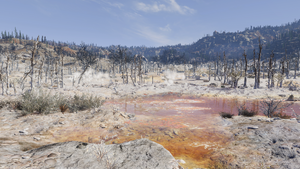
White powder, sewers for waterways, and almost no living creatures in sight.
Surrounding the city of Grafton, the Toxic Valley is a term referring to a stretch of land surrounding the city and Grafton Steel, once the largest employer in this corner of Appalachia. The company's irresponsible practices coupled with a casual disregard for the environment turned a lush region popular with tourists and investors alike into a desolate wasteland covered with industrial white powder and polluted water sources. The lake and other polluted waters of the Toxic Valley region are home to all manner of mutated, aquatic beasts, while a demented AI - the current mayor of Grafton claims dominion over the land.[18]
Savage Divide
The Appalachians bisecting West Virginia were a popular vacationing spot, including numerous natural parks and an extensive infrastructure to support the burgeoning tourist industry: Ski resorts, bed and breakfasts, cabins, and countless hiking trails were popular with Americans seeking refuge from the challenges of everyday life. The remoteness and isolation of the mountains also made the region popular with the military, which heavily invested in classified military bases and infrastructure to bolster the war effort abroad and quell dissent on domestic soil.[19]
Numerous landmarks dot the region's rocky landscape, lovingly dubbed the Savage Divide by survivors. The most notable include The Top of the World, an enormous ski lift station, complete with shops and restaurants at its peak, the Palace of the Winding Path with its unique architecture, and of course, the historic Whitespring Resort and the many secrets it hides.[16]
The Mire
A loosely-defined marsh region east of the Appalachians, roughly centered around Harpers Ferry, the Mire was once a densely forested area with numerous swamplands. Historically a major transportation hub, due to the confluence of the Potomac and Shenandoah rivers at Harpers Ferry, the Mire was most known in the 21st century for the Free States movement that heavily invested in private nuclear shelters, skeptical of the government's efforts and intentions for its citizenry. The explosion of the Vault 94 G.E.C.K. created a rapidly mutating, expanding bog together with a number of unique mutations like anglers and numerous plant species.[20] The strangler plant, which is entirely unique to the Mire, has largely grown unabated after the Great War and is a common sight in the Mire constricting around buildings, trees, and even unearthing swaths of land and into the air.
Although most of them would eventually die out in the coming decades, eventually isolated to the most unique ecosystems like the Island, they would prove to be enough to wipe out most human habitation in the Mire, including the Free States that once called the land their home.[20]
Cranberry Bog
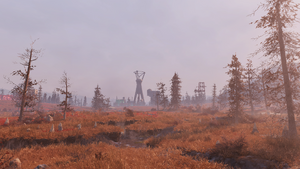
Former Watoga National Park and Watoga visible in the distance.
Occupying the southeastern corner of Appalachia, the Cranberry Bog took its name from the colorful red flora endemic to the area. Once much of the area was protected by a national park, until it was shuttered and the entire region was opened up to commercial development, exemplified by the foundation of Watoga in 2042. 35 years of logging, expansion, and eventually even underground nuclear tests performed by AMS culminated in a vast expanse of rapidly desertifying wilderness, with Watogan high-rises towering above the destruction wrought by corporate interests. Those who lived outside the city were steadily pushed out by the encroaching AMS and their cronies, right up until the Great War, when a virus released by a saboteur turned the city's robotic custodians against its human inhabitants.[21]
After the nuclear war erased the United States, the Bog became one of the least popular destinations among survivors, as much due to the deteriorated natural environment and killer robots as due to the emergence of a variety of hostile mutations, including carnivorous plants. The remoteness and isolation of the Bog made it perfect for the Enclave's experiments. President Thomas Eckhart used the region to hide his scorchbeasts until 2085, when he unleashed them on Appalachia to fulfill his mad dreams. The Bog became a stronghold of the monstrosities, which managed to destroy their handlers and even the Appalachian Brotherhood of Steel that tried to stem the tide using a ring of fortifications established on the Bog's perimeter.[21]
Environment
While the predominately rural landscape is mostly unscathed by nuclear weapons, it has not escaped environmental damage entirely. Radioactive fallout from other areas of the former United States has mutated much of the local wildlife, unchecked coal mine fires have blanketed an area centred around Mount Blair in ash, factories and industrial sites around Clarksburg started churning out pollutants cloaking the area in a white powder, and a G.E.C.K. in Vault 94 was destroyed by a group of wastelanders, causing heavily mutated plant life in the northeast.
Of particular concern is the Scorched Plague, caused by a hazardous, mutagenic fungus indigenous to the vast caverns beneath Appalachia. It is spread by scorchbeasts, which periodically breach the surface and terrorize the countryside.
Organizations
In the aftermath of the Great War, a number of factions formed among the survivors, including continuations of pre-War groups like the Enclave and Free States, along with post-War organizations such as the Brotherhood of Steel, raiders and Responders. These groups were all wiped out prior to 2102 by the Scorched, though there are some remnants such as the Enclave's AI, MODUS.
Appearances
Appalachia appears only in Fallout 76. It is also mentioned by name in the Fallout 4 Creation Club content "Capital Wasteland Mercenaries."[22]
Gallery
- ↑ 1.0 1.1 1.2 Real-life history.
- ↑ Fallout 76 loading screen hints: "Late in 2060, the U.S. military deployed their unmanned Cargobots all over Appalachia. They proved ideal for providing reconnaissance and delivering supplies in even the most hostile conditions."
- ↑ Herald Editorial on Allegheny Asylum
- ↑ Watoga
- ↑ The Rusty Pick
- ↑ See Free States for references.
- ↑ Sam Blackwell: "NO" on Measure 6
- ↑ Hornwright Industrial headquarters terminal entries
- ↑ Charleston Herald - Hornwright Wins!
- ↑ See Enclave for references.
- ↑ : "6.8.2079 Sender: [K.Baker] >> They've left their bunkers Chandler got back last night. Said that the Free States have left their bunkers and retaken Harpers Ferry. Those tinfoil hats may have had the right of it all along cause they seem to have plenty of food and supplies. We still haven't been able to figure out what's been creating that weird mire out there. She did see some other paramilitary looking folks out at the power plant, but they didn't seem to be with the Free States. Said they had power armor so she didn't try to approach. -Baker"
- ↑ See Charleston for references.
- ↑ Riverside Manor
- ↑ See Appalachian Brotherhood of Steel
- ↑ Fallout 76 main storyline.
- ↑ 16.0 16.1 16.2 Fallout 76 loading screen hints
- ↑ 17.0 17.1 See The Ash Heap for references.
- ↑ See Toxic Valley for references.
- ↑ See Savage Divide for references.
- ↑ 20.0 20.1 See The Mire for references.
- ↑ 21.0 21.1 See Cranberry Bog for references.
- ↑ Scratch's logs

